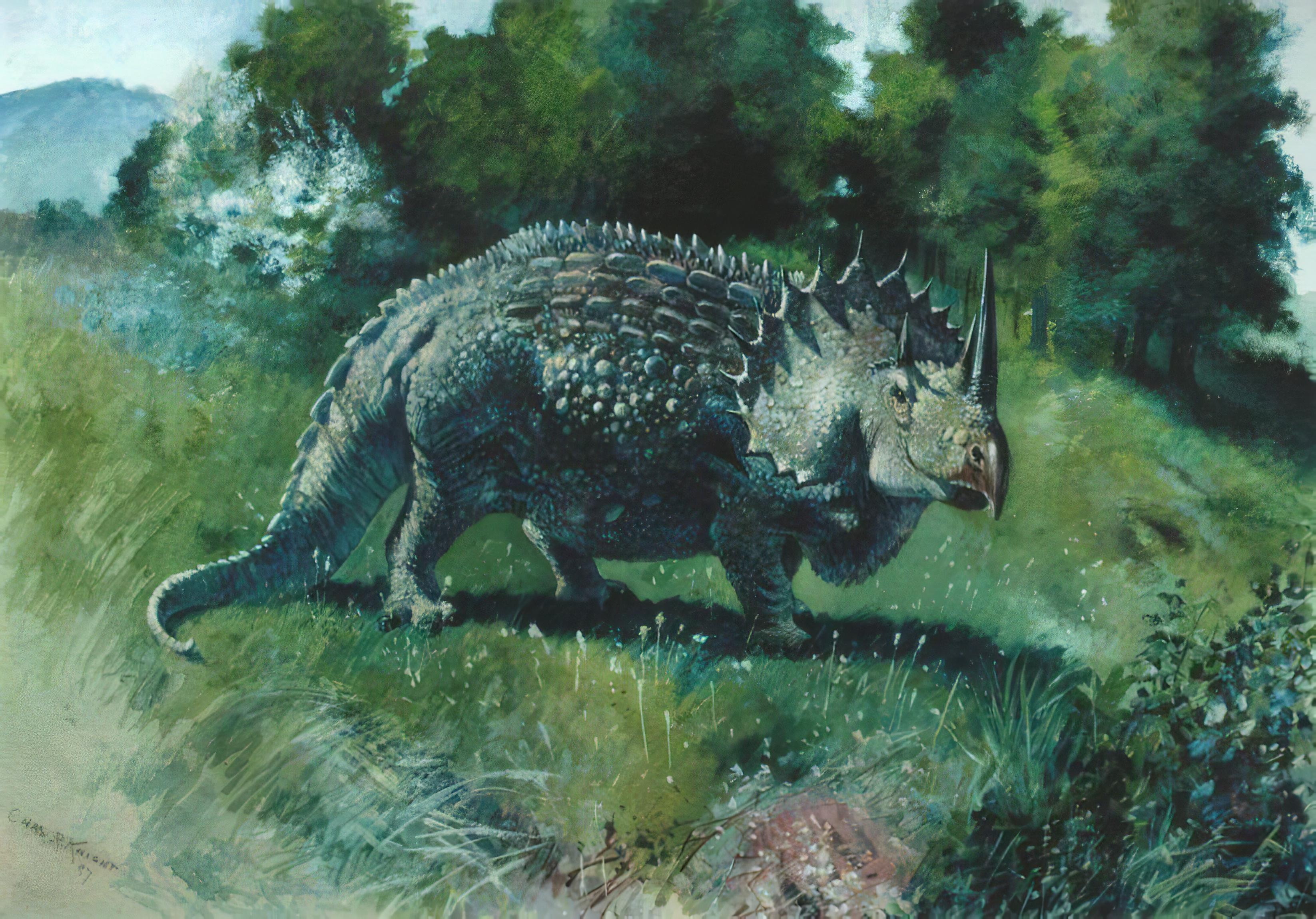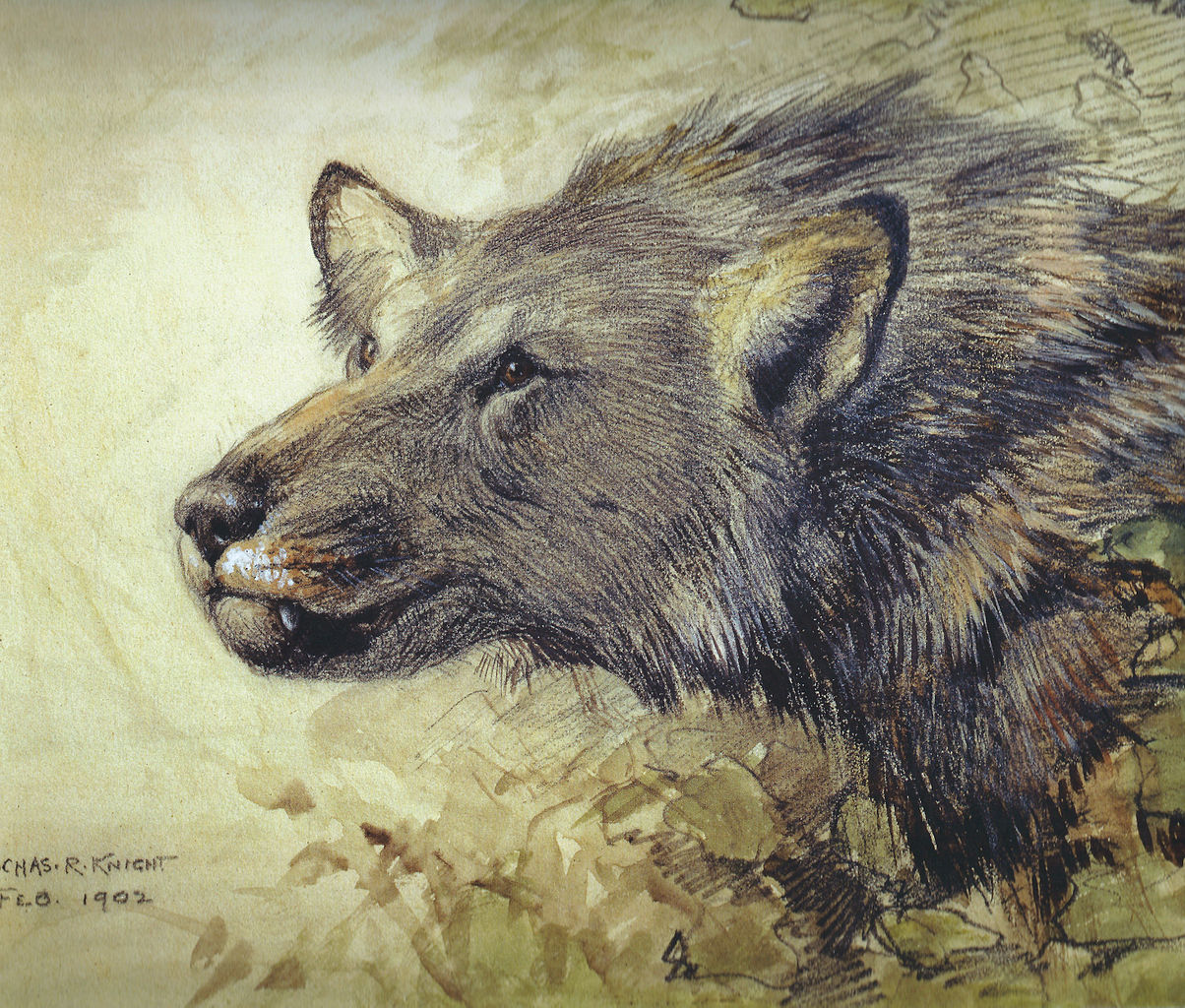Tyrannosaurus rex ‘the king of the tyrant-lizards’ is the most iconic of all dinosaurs, the largest land predator that ever walked the Earth.
Anatomy
A heavily-built beast, with a broad snout, which flared out into even broader cheeks, a short thick neck, a stout body, relatively tiny arms, long legs, and a thick tail. The diminutive forelimbs had two claws each, while the hind feet had three which came into contact with the ground and one which didn’t. Its teeth were long, sharp, and set into a massive skull which could deliver intense bite forces. Lizard-like lips concealed the teeth, protecting them from the elements. Ridges of heavy scales covered the snout and curved back around the eyes. The skin of adults seems to have been entirely featherless and covered with small, round, non-overlapping scales.
Movement
Although its long legs enabled long, energy-efficient strides, a fully grown tyrannosaur could not take advantage of this to achieve high speeds without risking injury. The colossal impact of each step was only somewhat managed by the thick cushioning on each foot.
Senses
Although its eyes are almost lost in the massive face, they were actually some of the largest of any animal. They seem to have been optimised for daylight and tyrannosaurs may have had vision better than birds of prey. Their hearing and sense of smell would also have been very good, with brain regions relating to them being enlarged.
Intelligence
Despite being stereotyped as crude and stupid, tyrannosaurs had relatively large brains, and would probably have been smarter than most reptiles, and possibly many birds and mammals. However, with large amounts of brain dedicated to processing sensory information and precise control over movement, it is doubtful there was much to spare for more abstract thinking.
Social Behaviour and Hunting Strategies
There is some evidence that tyrannosaurs lived in groups, although it is impossible to say how big they were or what social structures they formed. One hypothesis is that adults and young worked as a ‘combined arms’ team where the juveniles herded prey into the path of mature predators. If this wasn’t the case, they would have hunted different prey, occupying different ecological niches at different stages of development. While younger individuals could run their prey down quickly, older ones may have had to rely on ambush, or wearing down their target with lengthy pursuit. Few other large or medium sized predators seem to have been able to compete with them.
Habitat
T. rex lived across a huge area with multiple different types of terrain, from forests to semi-arid plains, but it was most common in the wetlands bordering the Western Interior Seaway (where the Great Plains are now). These would have been similar to the modern bayous of the Gulf Coast.
Tyrannosaurus rex
ST 46; DX 11; IQ 3; HT 12.
HP 46; Will 11; Per 13; FP 12; Speed 5.00; Dodge 8; Move 5.
SM +4 (20 hexes), 12,000 lbs.
Bite (13): 6d+4 impaling. Reach C. If a bite hits, can grapple with effective ST 48.
Claw, Slash (13): 1d−1 cutting. Reach C.
Claw, Grapple (11): Reach C. Effective ST 14.
Stamp (10): 5d+6 crushing. Reach C.
Tail-Swipe (13): 5d+10 crushing. Reach 3. Rear only.
Trample (13): 5d+5 crushing. Against SM +2 (+3 if prone) or less.
Traits: Acute Vision 2; Born Biter 2; Discriminatory Smell; DR 3 (Tough Skin); DR 3 (Face Only); Ham-Fisted 2; Limited Camouflage; 2 Short Arms; Silence 1; Striker (Tail; Cannot Parry; Limited Arc, Rear); Striking ST 5 (Bite only); Subsonic Hearing; Weak Arms (¼ ST); Wild Animal.
Skills: Brawling-13; Hiking-16; Intimidation-12; Stealth-12; Survival (Swampland)-13; Swimming-14; Tracking-17; Wrestling-13.
This profile represents a typical adult T. rex. The very largest (18,000 lbs.) get ST and HP 52, giving effective ST 54 with a biting grapple and 15 with a claw grapple. Damage increases to 6d+7 with a bite, 1d with a claw, 6d+6 with a stamp, 6d+12 with the tail, and 6d+5 when trampling. For a small adult or nearly-mature sub-adult (7,000 lbs.) reduce ST and HP to 38, SM to +3 (16 hexes), DR (both) to 2, and Striking ST to 3. This changes effective ST to 40 with a bite grapple, 12 with a claw grapple. Tail reach becomes 2 and maximum SM for trampling victims becomes +1. Damage changes to 4d+5 with a bite, 1d−2 with a claw, 4d+5 with a stamp, 4d+8 with the tail, and 4d+4 when trampling.
Juveniles
Young tyrannosaurs looked quite different to the adults. They were small, lightly-built, very long-legged, and probably covered in fluffy proto-feathers for insulation. Smaller body mass allowed them to run faster than their parents.
ST 25; DX 11; IQ 2; HT 12.
HP 25; Will 10; Per 12; FP 12; Speed 5.00; Dodge 8; Move 5.
SM +2 (9 hexes), 2,000 lbs.
Bite (12): 2d+1 cutting. Reach C. If a bite hits, can grapple with effective ST 26.
Claw, Slash (12): 1d−5 cutting. Reach C.
Claw, Grapple (10): Reach C. Effective ST 7.
Kick (10): 2d+2 cutting. Reach C-2.
Tail-Swipe (12): 2d+4 crushing. Reach 2. Rear only.
Traits: Acute Vision 1; Born Biter 2; Discriminatory Smell; DR 1 (Tough Skin); DR 1 (Face Only); Enhanced Move 1 (Ground Speed 10); Ham-Fisted 2; Limited Camouflage; 2 Short Arms; Silence 1; Striker (Tail; Cannot Parry; Limited Arc, Rear); Subsonic Hearing; Weak Arms (¼ ST); Wild Animal.
Skills: Brawling-12; Stealth-12; Survival (Swampland)-12; Swimming-13; Tracking-15; Wrestling-12.
For an even younger juvenile (200 lbs.) reduce ST and HP to 12. This changes damage to 1d−2 with a bite, 1d−6 with a claw, 1d−1 with a kick, and 1d with a tail-swipe.
Alternative Takes
Early interpretations of T. rex were essentially similar to the current scientific consensus: it was a slow-moving predator with many lizard-like features, about 40 feet long and weighing around six tons. The main differences were that it was often portrayed in a somewhat upright tail-dragging posture, and that it was believed, like most dinosaurs, to be profoundly stupid. Reduce adult IQ to 2 and remove Enhanced Move on the juvenile to represent such creatures.
Tyrannosaurus rex, by Charles R. Knight (1940)
Some have suggested that tyrannosaurs were more scavengers than hunters. Large terrestrial scavengers are rather rare, and it seems unlikely that a warm-blooded animal of such size would be able to find enough carrion to sustain it. However, if you want to create a giant land vulture, add Reduced Consumption (Cast-Iron Stomach) or Resistant to Disease, remove the Stealth skill, and increase Survival. Either hunting or scavenging could have been combined with kleptoparasitism, stealing the kills of smaller predators. Given their dominance of all ecological roles for large predators, this could mean mostly stealing from their own species! Improve Intimidation if this is a major source of food.
A more recent trend was to assume that they could sprint quite fast. The latest computer modelling suggests that the leg bones of a full-sized adult would crack under the strain of moving more than about 11 miles per hour. Add up to 2 levels of Enhanced Move to the adult if you wish to ignore that.
Many skeletons which are generally accepted as belonging to T. rex have been classed as different species at some point. Any of the alternative profiles could be used for one of these species. For example, a fully grown T. imperator would use the largest adult profile.
The Limited Camouflage perk reflects the fact that pack hunting or ambush require significant stealth, so some form of camouflage seems likely. Scavengers and long-distance pursuit predators may not need concealment, and so adult tyrannosaurs who use such tactics may lack effective camouflage.
Aesthetic details like whether they had lips (and, if so, how large) and the possible presence of some proto-feathers on adults make no difference in the rules but has long been the subject of passionate debate.









